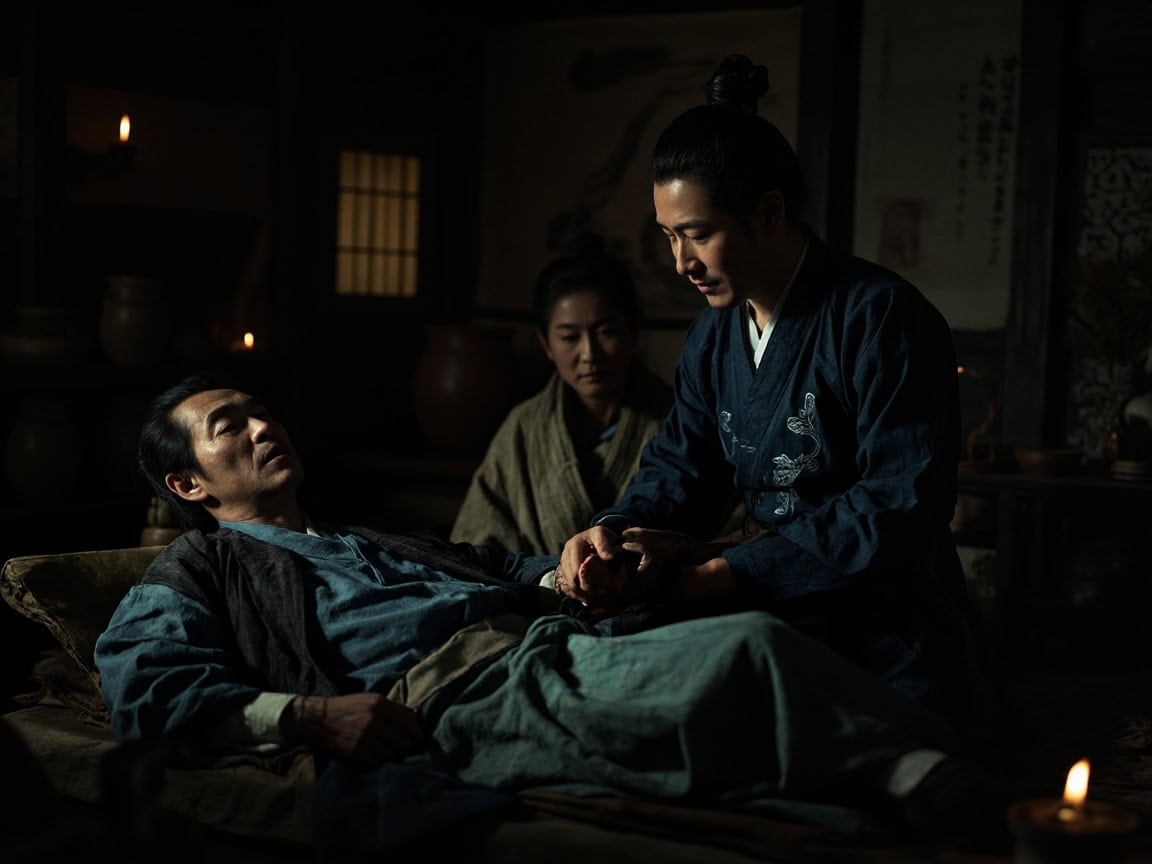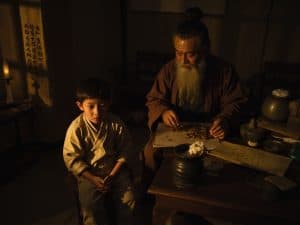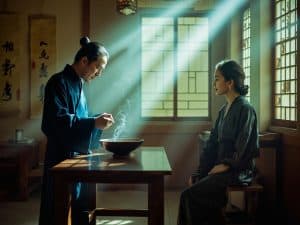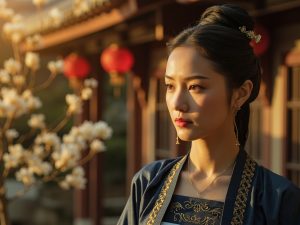Table of Contents
ToggleTraditional Chinese Medicine Case Analysis 6:Constipation, Fever, Anhidrosis
Author: Gu Yuxi Editor: Gu Yuxi Translator: Gu Yuxi
Traditional Chinese Medicine (TCM) Case Analysis from “Shang Han Jiu Shi Lun” (Treatise on Cold Damage, Ninety Discussions) by Xu Shuwei, Song Dynasty: Yangming Disorder Requiring Purgation (VI)
Original Text:
Yi wu bian Li xing. Zai Xuanhua zuo jing. Shanghan wu liu ri yi. Zhen wu yi. Di jun zhao yu. Yu zhen shi zhi yue. Mai hong da er chang. Dabian bu tong. Shenre wu han. Ci yangming zheng ye. Xu xia. Bingjia yue. Bingzhe nian yu qi shi. Kong bu ke xia. Yu yue. Re xie du wasi bing xu yu yangming. Kuang yangming jingluo duo xue shao qi. Bu wen lao zhuang. Dang xia. Bu er bie qing yi zhan. Zhu bingzhe yue. Shen ke xia. Yi ting suo zhi. Yu yi da chengqi tang. Ban ri. Shu weizhi. Zhen qi bing. Cha qi zheng wanran zai. Yu yue. Yao ceng jin fou. Zhuzhe yue. Kong qi ruo bu jin. Dan fu qi ban er. Yu yue. Zai zuo yi fu. Qin shi yin zhi. Bu ban shijian. Suo ni qi. Xian xia zao fen shi shu mei. Ci tang xie yi xing. Hui bu ke jin. Wei li yi zhong han yi. Ran zhoushen. Yi shi qing. Han zhi shen liang. Zhu ku sui chu. Ci ri yu zi zhen gui. Binghuan suo buji. Yu yue. Fu da chengqi tang de cha. Bu yi fu buji. Bu ze re reng fu. Zi ci dan shi zhou. Xun ri ke ye. Gu yu zhi ci ji. Zhongshen zhi da chengqi. Yi fu er yu. Wei you ruo ci zhi jie. Lun yue. Lao zhuang zhe xing qi ye. Han re zhe bing xie ye. Zang you re du. Sui shuai nian yi ke xia. Zang you han xie. Sui zhuangnian yi ke wen. Yao zhi yu bing xiangdang er. Shi ci. Shi zhi su bi ye. Jin zhi.
Translation:
A military officer named Li, serving as a border guard in Xuanhua, had been suffering from cold damage for five or six days. There was no physician in town, so he came to my residence and asked me to treat him. After examining him, I said, “The patient’s pulse is surging, large, and long; he has constipation, fever, and anhidrosis. This is a Yangming disorder, and purgation is required.” The patient’s family said, “The patient is over seventy years old; I fear purgation is not advisable.”
I replied, “Pathogenic heat and toxic qi are accumulated in Yangming, affecting the physiological function of the stomach and intestines. Furthermore, the Hand Yangming Large Intestine Channel is rich in blood and qi. Regardless of age, whether old or young, purgation should be employed. Otherwise, please seek another physician.” The patient’s attendant replied, “If you are certain purgation is appropriate, we will follow your treatment.” So, I administered Da Chengqi Tang.
After half a day, to my surprise, the patient’s symptoms remained unchanged. I asked, “Was the entire decoction consumed?” The attendant replied, “I was concerned about his qi deficiency and inability to withstand the purgation, so he only took half.” I said, “Prepare another dose,” and personally supervised him as he drank it. In less than half an hour, the patient requested a urinal. He first discharged a dozen dry stools, followed by one loose, foul-smelling evacuation that was unbearable to be near. Before I had even left, the patient was already sweating profusely all over his body. In about an hour, the sweating stopped, his body cooled, and all his distress subsided.
The next day, when I returned from town, the patient requested a tonic. I said, “Having recovered by taking Da Chengqi Tang, it is not advisable to take a tonic. If a tonic is taken, the heat will return. You now only need to eat some congee and recuperate for about ten days.” When treating this type of illness characterized by vigorous heat, I always use Da Chengqi Tang, achieving a cure with a single dose. There is no other formula that acts as swiftly as Da Chengqi Tang.
The text discusses that a person’s old age or vigor depends on their own upright qi, while cold is caused by external pathogenic evils. If there is heat toxin within the zang organs, even an elderly person can undergo purgation. If the heat evil is excessive, even an elderly person can undergo purgation. The key is that the treatment method must correspond to the illness. Violating this principle will lead to adverse outcomes. Therefore, one must proceed cautiously in clinical practice.
【Traditional Chinese Medicine Syndrome Differentiation Approach】:
Differentiating the Six Diseases:
- Urinary Retention: Absent.
- Taiyang Disorder: Absent.
- Yangming Disorder: Present. Pulse is surging, large, and long. Constipation. Fever with anhidrosis.
- Shaoyang Disorder: Absent.
- Shaoyin Disorder: Absent.
- Taiyin Disorder: Absent.
- Jueyin Disorder: Absent.
Differentiating Miscellaneous Diseases:
- Qi Deficiency: Possible. Fever with anhidrosis. No aversion to cold, no body pain.
- Blood Deficiency: Absent.
- Fluid Retention: Absent.
- Food Stagnation: Present. Constipation.
- Phlegm Obstruction: Absent.
- Blood Stasis: Absent.
- Other Miscellaneous Diseases: Absent.
Summary:
This is a very typical Yangming disorder, fully conforming to the guiding principle symptoms of Yangming disease—[9.2] “Yangming disease is characterized by repletion in the Stomach.” However, this patient has one symptom – anhidrosis – which does not conform to the external manifestations of Yangming disease. Normally, Yangming disease definitely involves sweating, especially with Yangming food stagnation, where sweating would be even more pronounced, with intermittent sweating on the hands and feet (sweating profusely). Generally, if a patient should be sweating but cannot, there are two possibilities. One is that the Xuanfu (pores) are obstructed; in simple terms, the skin pores are closed, preventing sweat from exiting.
In this medical case, this is entirely possible. The Huangdi Neijing (Yellow Emperor’s Inner Canon) states a key point: “Yang Mi Nai Gu” (Yang, when dense, is firm). Here, “Yang” includes the body’s Yang Qi and pathogenic heat. If the Yang is too dense and vigorous, it can solidify and close off the Xuanfu. The anterior and posterior orifices can also be considered part of the Xuanfu, like special large pores on the skin. The other possibility for anhidrosis is that there is insufficient body fluid (Jin Ye) to produce sweat.
Regardless of the possibility, urgent purgation to preserve Yin should be employed. If the cause is Xuanfu obstruction, it indicates that even though the patient is elderly, their Yang is sufficient for purgation without problems. If the cause is Jin Ye deficiency, then purgation is even more necessary. Here, Da Chengqi Tang is the only choice because Xiao Chengqi Tang, lacking Mirabilitum (Mang Xiao), might not achieve successful purgation, and Mirabilitum can also clear excess heat.
The Shanghan Zabing Lun passage corresponding to this Traditional Chinese Medicine case:
Differentiation of Yangming Disease Pulse and Treatment 9.76:
[9.76] “For cold damage of six or seven days, with indistinct vision, disharmony of the pupils, no exterior or interior symptoms, difficult defecation, and slight fever, this is repletion. Urgently purge with Da Chengqi Tang.”
Why was this particular differentiation selected among so many for Da Chengqi Tang? Primarily because “indistinct vision and disharmony of the pupils” are caused by the internal scorching of pathogenic heat and dryness of Jin Ye, which is quite similar to the anhidrosis and fever in the medical case. Other symptoms are largely the same.
Hu Xishu’s Interpretation of This Differentiation:
Unfortunately, the audio recording of Elder Hu’s interpretation of this specific differentiation is missing, so there is no direct commentary available. However, he has discussed related content elsewhere:
“Da Chengqi Tang should not always be used conventionally. There are three types of urgent purgation syndromes: first, ‘indistinct vision and disharmony of the pupils’; second, ‘fever with profuse sweating’ – this is also critical, as Jin Ye will soon be exhausted, and urgent purgation is necessary regardless of whether the stool is hard; third, ‘abdominal fullness and pain immediately after sweating,’ which is both full and painful, indicating a rapid onset of the illness. These must be remembered; otherwise, you won’t grasp them well in clinical practice.”
Formula: Da Chengqi Tang
Source: Shanghan Zabing Lun
Composition:
- Da Huang (Rhubarb) 12g (washed with wine)
- Hou Po (Magnolia Bark) 24g (roasted, peel removed)
- Ji Shi (Fructus Aurantii Immaturus) 15g
- Mang Xiao (Mirabilitum) 20g
Preparation:
Above four ingredients, add ten dou of water. First, decoct the two ingredients (Hou Po and Ji Shi) until five sheng remain. Remove the dregs. Add Da Huang and decoct again until two sheng remain. Remove the dregs. Add Mang Xiao and warm slightly for one or two boils. Take in divided doses. If purgation occurs, do not take the remaining portion.
Hu Xishu’s Dosages:
- Wine-washed Da Huang: 12g
- Hou Po: 24g
- Zhi Shi: 15g
- Mang Xiao: 20g
Hu Xishu’s Formula-Syndrome Pattern:
Da Chengqi Tang consists of Da Huang, Mang Xiao, Hou Po, and Zhi Shi. Mang Xiao primarily acts to clear heat, soften hardness, and unblock the bowels. It treats heat; for instance, it’s used for tidal fever. When combined with Da Huang, its purgative effect is quite strong. If qi-regulating and distension-reducing herbs are also used, the purgative effect becomes even more intense. Thus, Hou Po at half a jin (24g) is a significantly heavy dosage. Zhi Shi, five pieces, currently equates to about five or six qian, with larger Zhi Shi pieces being even more.
We don’t use such heavy dosages nowadays. Da Huang and Mang Xiao are typically three or four qian, at most five or six qian, and that’s only for severe cases. Hou Po and Zhi Shi are usually four or five qian; such dosages are sufficient. Therefore, we say Da Chengqi Tang can treat great repletion, great fullness, and great pain. Severe distension, severe heat, and pain. This formula has a considerably large dosage and is quite potent. So, when using this formula, one must always be cautious. There must be tidal fever, and the stool must be hard.
It’s easy to misunderstand here: Da Chengqi Tang is not exclusively for hard stools. Hard stool is a timing indicator for using Da Chengqi Tang. The entire condition of “heat repletion in the interior” is called a Yangming disorder. The application of Da Chengqi Tang must have hard stools as a necessary criterion; it cannot be used if the stools are not hard. If Da Chengqi Tang is seen as solely targeting bowel movements, that’s incorrect. It treats the illness, and hard stool is a timing indicator for using Da Chengqi Tang.
“Be cautious when caution is due, be bold when boldness is called for.” You must use Da Chengqi Tang when it’s indicated. If you delay until the patient becomes delirious, or even later, to staring straight ahead, developing dyspnea, or diarrhea, it’s too late. You must attack when indicated. If you don’t dare to attack, and the evil becomes replete while the upright qi becomes deficient, you’ll be at a loss: if you tonify deficiency, it will only worsen the repletion; if you expel the evil and attack the repletion, the person won’t be able to withstand the medicine and will surely die. Then, at the point of collapse, it’s even worse; death will naturally ensue. Such misdiagnosis and mistreatment are not uncommon in clinical practice, though I haven’t seen them much in recent years. In the past, when private practice was common, I often saw them. This is because now, patients with these conditions are hospitalized. If there’s mistreatment, they die in the ward.
In clinical practice, we also need to be diligent and palpate the patient’s abdomen. In a true Da Chengqi Tang syndrome, the abdomen cannot be touched; the patient is extremely averse to abdominal pressure.
“Those with gasping and dizziness who cannot lie down”: Gasping (Chuan) and dizziness (Mao) are both signs of repletion. Although the heat externally appears subtle, its upward attack is quite fierce. “Mao” is dizziness and confusion; the heat attacks upwards, which is why it doesn’t manifest prominently externally. On one hand, it’s knotted in the interior, and on the other hand, it attacks upwards, so this situation should not be underestimated. “Chuan” (gasping) is not the external type of gasping but rather dyspnea caused by heat overwhelming and pressing on the diaphragm. “Huan Mao” (dizziness and confusion) is also caused by heat attacking the head and brain. Clinically, Da Chengqi Tang is used.
Furthermore, do not always adhere to conventional rules when using Da Chengqi Tang. There are three types of urgent purgation syndromes: one is “indistinct vision and disharmony of the pupils”; the second is “fever with profuse sweating,” which is also critical, as Jin Ye will soon be exhausted, and urgent purgation is necessary regardless of whether the stool is hard; the third is “abdominal fullness and pain immediately after sweating,” which is both full and painful, indicating a rapid onset of the illness.
It is worth mentioning toxic dysentery, which presents with persistent high fever, dry heat, no diarrhea, occasional coma, a surging and rapid pulse, and a grayish-white complexion. This is an urgent purgation syndrome; Da Chengqi Tang should be used without hesitation.
Disclaimer:
The experiences and insights shared above represent the author’s personal usage and understanding, and are provided for reference only as part of academic exchange. Please do not blindly replicate or apply them; any consequences arising from such actions are solely your responsibility. As individual constitutions vary, medication should be tailored accordingly. It is advisable to use such treatments under the guidance of a qualified physician. If you have additional experiences to share, comments and submissions are welcome.
If you appreciate my article, please give it a like.
If you are a generous and affluent individual, please consider making a donation!
Your recognition is my greatest motivation to continue writing—thank you very much!
USD Donation Button —
A RMB donation button is available below.
 微信赞赏
微信赞赏 支付宝赞赏
支付宝赞赏




